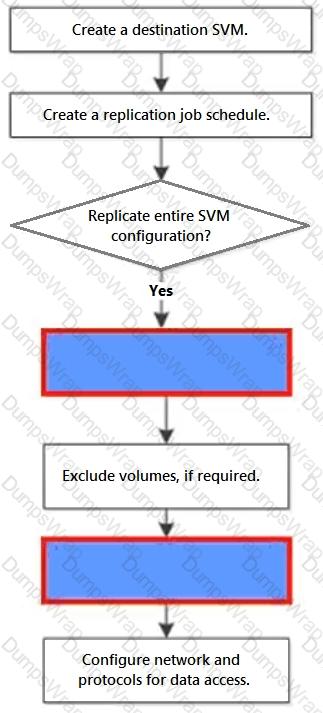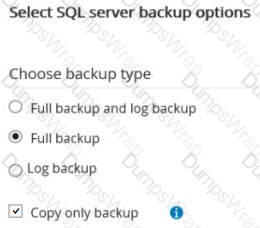NetApp Certified Implementation Engineer - Data Protection Questions and Answers
Click the Exhibit button.

You need to verify that you have a 10 Gb path between two clusters for SnapMirror traffic. Referring to the exhibit, how fast is the network path between the clusters?
Click the Exhibit button.

Referring to the exhibit, which volume has the highest level of protection assigned to it?
You are deploying amission-critical business application for a healthcare customer that, according to government policies and regulations, requires zero data loss.
In this scenario, which NetApp solution enables you to set up data replication at a volume level to satisfy your business needs?
You are creating a SnapVault relationship and have concerns about the available capacity on the destination.
In this scenario, which three factors must you consider when you size the destination volume? (Choose three.)
You decide to enable SnapMirror network compression on your NetApp clustered Data ONTAP environment. Which two statements are correct about enabling this feature?
(Choose two.)
Click the Exhibit button.

Using the NetApp Cloud TCO calculator, a customer wants to determine whether running Cloud Volumes ONTAP in Azure will be more costeffective than running native cloud services.
Referring to the exhibit, which action would satisfy the requirement?
Click the Exhibit button.

You must set up SVM replication for the first time using CLI. This replication will be used for DR purposes. The SVM configuration does not need to be replicated at this time. In this configuration, you will be reusing a default policy.
Referring to the exhibit, what are two missing steps from the SVM replication workflow? (Choose two.)
Click the Exhibit button.

Commvault IntelliSnap and NetApp SnapCenter are both being used to back up the same Microsoft SQL Server database.
Referring to the exhibit, which action will SnapCenter perform on the Microsoft SQL transaction logs?
Click the Exhibit button.

A customer wants to ensure that their volumes are protected. In ONTAP System Manager, under the Protectionsection, you see the screen that is shown in the exhibit. The company has an asynchronous mirror policy of less than a 60-minute lag.
Referring to the exhibit, which volume has a lag that exceeds the company policy?
A customer is planning the cloud strategy for their Microsoft SQLdatabases and must be able to protect them from outages. They are planning on using multiple cloud providers for their solution with their current NetApp storage system.
In this scenario, which two products are required to satisfy their backup managementneeds? (Choose two.)
You are asked to provision some new storage for VMware. Which two tools are available to perform this task?(Choose two.)
Click the Exhibit button.

Referring to the exhibit, what must be performed on nodes aff-01 and aff-02 to allow them to failover and giveback properly?
Your customer needs to activate a destination SVM DRfollowing a disaster.
In this situation, which two actions should be performed? (Choose two.)
Which two NetApp features would help you to recover from a file share that was encrypted by a ransomware event? (Choose two.)
A customer wants to set up SNMP to monitor their ONTAP platforms. Because of securityreasons, they need strong authentication and data encryption?
In this scenario, which SNMP version satisfies these requirements?
Your manager requires you to protect a production SVM called svm01 by using SVM-DR. Your manager insiststhat all configuration and data LUNs be replicated to the DR cluster. The destination SVM should be called drsvm01. You set up an SVM-DR relationship between the clusters, specifying that the – identity- preserve option is set to true. After the initial replication completes, you discover that the iSCSI LIF configuration has not been replicated to drsvm01.
What should you do to solve this problem?
Your customer wants to implement SVM DR, but the customer is not certain whether theidentity-preserve parameter should be enabled. The customer explains that the source and destination clusters are in different network subnets.
In this scenario, which SVM DR solution should the customer use?
When installing a new AFF A700s, you notice thatthe HA interconnect adapters use miniSAS HD. You subsequently consult Hardware Universe to find out that only 0.5M cables are supported. Due to the importance of the system data fields that use this link, you delay the installation until you can acquire 0.5M cables.
In this scenario, which two system data fields are communicated between HA pairs over the interconnect adapters? (Choose two.)
A client has a primary data center that is located in a coastal area where the forecast is calling for a Category 5 hurricane to make landfall in three days. The client’s data is protected using NetApp SVM SnapMirror replication technology with identity-preserve that is enabled. The data is mirrored to a destination cluster outside of the affected area. The client has scheduled a controlled maintenance window for tomorrow to ensure that dependable operations are maintained.
Which three steps must be taken to accomplish this task? (Choose three.)
You are asked to re-purpose a NetApp FAS cluster. You need to verify that all encrypted data has been securely erased.
Which two features would allow you to securely re-purpose the array? (Choose two.)
A previous administrator had configured an external backup system to use node-scoped NDMP for backups, but you want to change this system to use SVM-scoped NDMP. How do you make this change in ONTAP?
Your backup cluster reached both the maximum number of parallel replication transfers and the maximum number of FlexVol volumes per node. You need to increase these maximum numbers.
In this scenario, which license you would install on the destination to accomplish this task?
An ONTAP administrator is trying to configure a three-way-disaster recovery solution. Cluster 2 is within 50 km of Cluster 1, the primarycluster, with an RTT of 7 ms. Cluster 3 is over 300 km from Cluster 1 with an RTT of 29 ms.
In this scenario, what are two topologies that would accomplish this task? (Choose two.)

